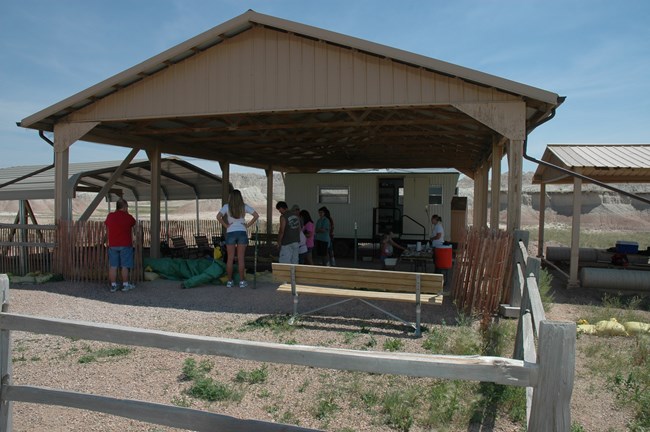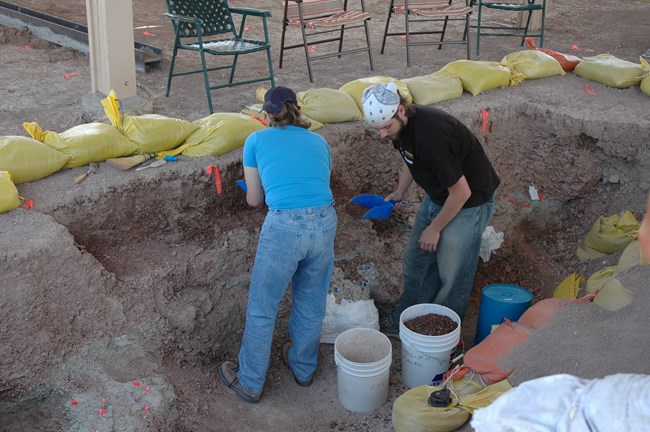Part of a series of articles titled Badlands Geology and Paleontology.
Article
The Big Pig Dig

NPS Photo
What’s the Big Pig Dig?
It is 34 million years ago. A once wet and hot environment begins to experience cooling and drying for the first time in four million years. During a time of drought, animals in the area are dying of thirst and looking for water wherever they can find it. There is one watering hole in the area, formed by a stream channel or an oxbow lake. As the surrounding area experiences drought, more and more animals are drawn to the watering hole. Weakened by thirst and desperate for water, some animals wander too far in and get stuck. As the area and the watering hole itself continues drying out, scavengers come along to eat the remains of dead or dying animals, walking over bones and pushing them further into the ground during that process. Some of those scavengers also get stuck and die – their bones get added to the ones getting pushed under the surface. All of these bones end up buried deep beneath the surface and fossilize. They won’t be seen again for about 34 million years.
In 1997, two visitors to Badlands National Park, Steve Gasman and Jim Carney, noticed exposed vertebrae (back bones) and limb bones just outside of the Conata Picnic Area. They did the right thing: instead of attempting to remove the bones themselves, they reported the fossils to park staff so that professionals could determine whether or not the fossils could be removed. The Big Pig Dig and Kylie’s Cat are both excellent examples of how visitors to the Badlands have made some of the most significant paleontological finds in park history.
Once notified of the fossils, park paleontologists decided that the bones were at risk for theft and erosion and needed to be removed. Park staff set out to remove the fossils from the area, unaware that they had started an excavation which would take 15 field seasons to complete. During this excavation, scientists and volunteers would unearth over 19,000 fossils and the story which came with them.

NPS Photo
How do we know this story?
How do we know the story of the Big Pig Dig with any certainty? It happened millions of years ago – no one was there to take pictures or write everything down. Instead, we have to rely on the knowledge of scientists like paleontologists and geologists to help us uncover these mysteries.
Geologists, people who study rocks and the earth, reported to the Big Pig Dig to help us understand more about what the environment of the Big Pig Dig may have looked like. The position of the fossils uncovered during the dig – some completely horizontal, others more vertical – gave hints to geologists about the original environment. The variety of bone positions suggested to scientists that as animals decomposed in the watering hole, their bones would float to the bottom of the lakebed and settle in different orientations. The size of sediment also helped unpack the story: small grains of rock and different patterns in grain sizes told geologists that the environment was probably fluvial, which means that it was related to a river.
Paleontologists, people who study ancient forms of life, helped us to understand the interactions of the different animals found in the Big Pig Dig. They suggested another answer to how some bones were found at high angles – perhaps scavengers were walking over the bones and shifting them out of place. Paleontologists also studied individual bones to help learn more about scavengers. The puncture marks on some bones were similar in size and shape to those which could be made by Archaeotherium, one of the fossils found in the dig. Scavenging by Archaeotherium could also explain why so many of the bones were disarticulated, meaning that they were separated from each other.

NPS Photo
What was the Big Pig? What were other fossils found during the dig?
A variety of animals were found in the Big Pig Dig, and scientists think that many of them would have been water-dependent, meaning that they would have relied heavily on watering holes in times of drought. Some of the animals found in the Big Pig Dig are:
-
Archaeotherium: Archaeotherium is the “Big Pig” for which the Big Pig Dig was named. It belongs to an extinct family of animals called entelodonts. Entelodonts were omnivores, meaning that they ate meat and plants. From evidence found in the Pig Dig, it’s likely that Archaeotherium was a scavenger, eating animals that were already dead or in the process of dying. Entelodonts, though they may superficially look like a giant pig, are actually closer related to the modern hippo than the modern pig.
-
Subhyracodon: Subhyracodon belongs to the family Rhinocerotidae and is related to the modern rhino. Although Subhyracodon is related to modern rhinos, it was actually hornless. Also unlike modern rhinos, which tend to be solitary, it is likely that Subhyracodon formed small herds. This animal was likely an herbivore which preferred riparian habitats adjacent to rivers.
-
Mesohippus: Mesohippus, belonging to the family Equidae, is an ancestor of the modern horse. Although Mesohippus is the ancient relative of the modern horse, it was only about the size of a large dog. Horse size gradually increased over the course of horse evolution. Mesohippus likely lived in herds and grazed on any available plants.
-
Leptomeryx: Leptomeryx was a tiny hornless mouse-deer which would have stood about a foot tall. Males would have had saber-teeth. Leptomeryx is related to modern mouse-deer, called chevrotains, which presently live in areas of South America and Africa.
Last updated: November 10, 2020
